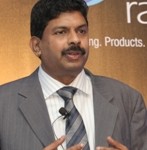

Very often, I’m posed with one standard question—how did Ramco Systems, one of the leading product companies, get onto offering such a grand ERP solution on the cloud? I’m not sure if people are all that flummoxed by this question. But now, I’ve decided to just about clarify their questions, through this blog.
As you all know, Ramco started as a product company close to 15 years ago; and ever since, we have tried out several versions of client server and innovations in web-based technologies. Now, we are proud to boast that our ERP applications are being successfully deployed in many customer sites, around the globe.
But, for a company like ours, which constantly thrives to make a difference, monotony is a completely tabooed term. How could we just about settle ourselves down with a few solutions? Don’t we need a new-age solution that can give us a better reach in the market?
When these questions started raking our brains, we felt the need to offer more to our customers. That is when we came up with the idea of offering ERP as a service, which we thought would turn out to be a novelty in business, specifically in the Indian market.
With this intent, we plunged into delivering ERP as a service, head on, and began delivering inherently multi-tenant applications in 2003. With this, we found ourselves sailing on our SaaS journey. Now, customers have begun using our ERP on demand. The complexities associated with ERP delivery are all taken away. Our first version of Ramco’s ERP on demand was launched in 2008.
Let me give you a little peek through the specifics of this SaaS solution. One instance of this ERP is deployed in the data centre, which customers may subscribe to. The customers’ data resides in separate databases, and the product behaviour is specific to each customer. In fact, the ERP itself is in components. Each of these components is available in flavours. The Component Interaction Model (CIM) strings the different components together, and the solution is delivered to the customer. UI layout changes, new components, further flavouring, business rules etc can also be customer specific.
We are now very happy to announce that close to 200 customers are associated with our On Demand ERP solution. Of these, over 70% are in the SMB space and use the application as is, with minor changes in reporting. . Larger customers such as Birla Tyres, NEC, Parry, and so on, demand extensive process variations. Ramco has provided these large customers with a sand box. Using tools such as the extension development kit, customers can create their own functionality, with minimal coding. These extensions are built by Ramco, its empowered team of delivery partners, or the customer’s IT teams. Typically, 70-80% of the delivery content is standard and the balance is customized (in case of large customers). Business rules reside in back-end manipulated data arrays, to deliver the necessary business results. We definitely do permit flexibility, but not at the cost of integrity. Ramco might also integrate the product with a business rules engine in future.
I hope this little report on how Ramco set sail in the ocean of cloud computing proved beneficial to you. Continue tracking this space for more of such interesting reads.
Posted By: Kamesh Ramamoorthy, COO, Ramco Systems

